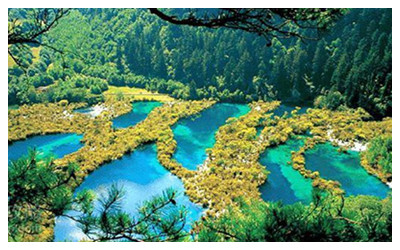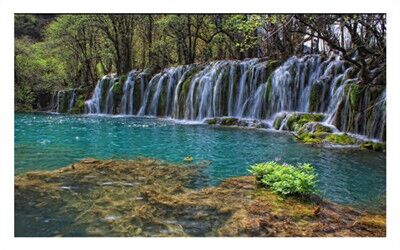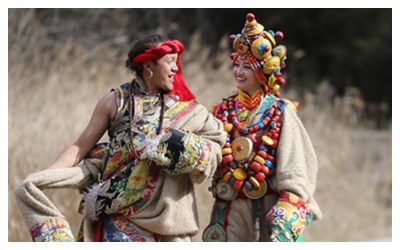Skype: neodalle-travel
Tel: +86 135 7447 2266
E-mail: sales@visitaroundchina.com

 Jiuzhai Valley or Jiuzhaigou National Park is located in the Aba Tibetan and Qiang Autonomous Prefecture of Sichuan Province, South Western China. It was declared a UNESCO World Heritage Site in 1992 and it belongs to the category 5 in the IUCN system of protected area categorization. Jiuzhai Valley literally means “Nine Village Valley” and is named after the nine Tibetan villages scattered throughout the park. There is evidence of people living in the national park up to 3,000 years and the local people still hold onto many of their traditional ways of life. The human population of the park is just over 1,000 which comprises of over 110 families.
Jiuzhai Valley or Jiuzhaigou National Park is located in the Aba Tibetan and Qiang Autonomous Prefecture of Sichuan Province, South Western China. It was declared a UNESCO World Heritage Site in 1992 and it belongs to the category 5 in the IUCN system of protected area categorization. Jiuzhai Valley literally means “Nine Village Valley” and is named after the nine Tibetan villages scattered throughout the park. There is evidence of people living in the national park up to 3,000 years and the local people still hold onto many of their traditional ways of life. The human population of the park is just over 1,000 which comprises of over 110 families.
The superb landscapes of Jiuzhai Valley are particularly interesting for their narrow conic karst land forms and spectacular waterfalls and lakes. There are over 220 bird species found in Jiuzhai Valley as well as a number of endangered plant and animal species, including the giant panda, Sichuan golden monkey and the Sichuan takin.
Jiuzhai Valley is part of the Min Shan mountain range on the edge of the Tibetan Himalayan Pletau and stretches over 720 sq km (72,000 hectares) with an extra buffer zone of 598 sq. km (60,000 hectares). The Min Mountains are one of South West China’s most important biodiversity typezones. The elevation of the national park ranges from almost 2,000m (6,500 feet) at the entrance to over 4,500m (14,760 feet) on the mountain peaks and the series of forest ecosystems are stratified by elevation.
 1978: Part of the area was protected as a nature reserve after heavy logging which began in 1975. The State Council issued its approval document for the Report on Strengthening the Works of Conservation and Domestication of Giant Pandas, and the report on establishing the Nanping-Jiuzhai Valley Nature Reserve.
1978: Part of the area was protected as a nature reserve after heavy logging which began in 1975. The State Council issued its approval document for the Report on Strengthening the Works of Conservation and Domestication of Giant Pandas, and the report on establishing the Nanping-Jiuzhai Valley Nature Reserve.
1982: The site was proposed as an area of Scenic Beauty and Historic Interest (National Park) by the State Council of the Chinese Government.
1984: Jiuzhai Valley National Park Administration Bureau was established.
1992: UNESCO experts concluded that Jiuzhai Valley “is an incredible place of great natural beauty. It meets the full standards and terms for the Natural Heritage” and was named a UNESCO World Heritage Site.
1994: The Chinese government named Jiuzhai Valley a state level Forest and Wildlife Nature Reserve and state level Nature Reserve.
1998: Jiuzhai Valley National Park was issued with the Man and Biosphere credential by UNESCO.
2002: Jiuzhai Valley National Park passed the authentication of the Green Globe 21.
2002: Jiuzhai Valley National Park suffered no physical damage in the May 12th Sichuan earthquake but the local economy was badly affected by the resulting downturn in tourism.
Local People in Jiuzhaigou
The total population of Jiuzhai Valley National Park is just over 1,000, comprising of over 110 families. The locals people of Jiuzhai Valley are Tibetan and thus speak the Tibetan language. The local Jiuzhai Valley Tibetan dialect is different to the Lhasa and Amdo Tibetan dialect of the grasslands. The dialects are so different that local people who only speak the local dialect would find it difficult, if not impossible, to communicate (verbally) with people from Lhasa, Aba Town or Qianghai who are not familiar with the Jiuzhai Valley dialect. As the area is increasingly exposed to the outside world, middle-aged and younger people have begun to speak mandarin Chinese. A few Tibetan words will still be lots of fun during your visit.
 The local people still hold onto many of their traditional customs and culture. Local food and drink traditionally include barley, yak meat and mutton. Barley is the main staple which is used for yak butter tea, barley wine, barley bread and in other dishes. The main religion practiced by the Jiuzhai Valley local population is the pre-Buddhism Bon or Benbo-Sec religion. It was introduced to the Aba Prefecture in the 2nd century B.C. In the 7th century, Tibetan Buddhism was introduced to the region. Although through numerous conflicts Buddhism did become prevalent, the Benbo Sec religion has survived and developed, and is now recognised as one of the five sects of Tibetan Buddhism.
The local people still hold onto many of their traditional customs and culture. Local food and drink traditionally include barley, yak meat and mutton. Barley is the main staple which is used for yak butter tea, barley wine, barley bread and in other dishes. The main religion practiced by the Jiuzhai Valley local population is the pre-Buddhism Bon or Benbo-Sec religion. It was introduced to the Aba Prefecture in the 2nd century B.C. In the 7th century, Tibetan Buddhism was introduced to the region. Although through numerous conflicts Buddhism did become prevalent, the Benbo Sec religion has survived and developed, and is now recognised as one of the five sects of Tibetan Buddhism. Ask Questions ?
Ask Questions ?